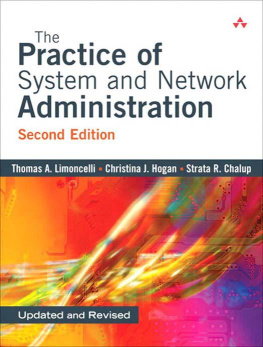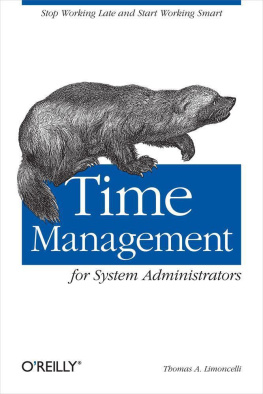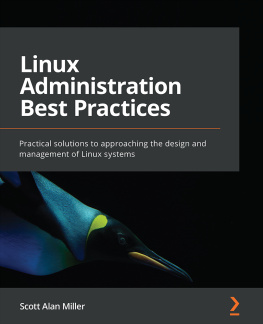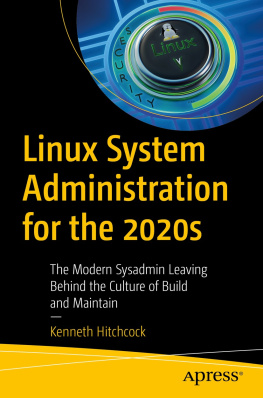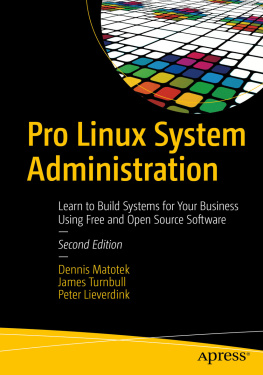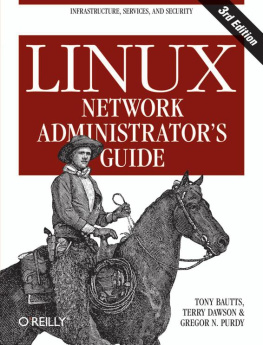
The Practice of System and Network Administration, Second Edition
Thomas A. Limoncelli
Christina J. Hogan
Strata R. Chalup

Upper Saddle River, NJ Boston Indianapolis San Francisco
New York Toronto Montreal London Munich Paris Madrid
Capetown Sydney Tokyo Singapore Mexico City
Many of the designations used by manufacturers and sellers to distinguish their products are claimed as trademarks. Where those designations appear in this book, and the publisher was aware of a trademark claim, the designations have been printed with initial capital letters or in all capitals.
The authors and publisher have taken care in the preparation of this book, but make no expressed or implied warranty of any kind and assume no responsibility for errors or omissions. No liability is assumed for incidental or consequential damages in connection with or arising out of the use of the information or programs contained herein.
The publisher offers excellent discounts on this book when ordered in quantity for bulk purchases or special sales, which may include electronic versions and/or custom covers and content particular to your business, training goals, marketing focus, and branding interests. For more information, please contact:
U.S. Corporate and Government Sales, (800) 382-3419,
For sales outside the United States please contact:
International Sales,
Visit us on the Web: www.awprofessional.com
Library of Congress Cataloging-in-Publication Data
Limoncelli, Tom.
The practice of system and network administration / Thomas A. Limoncelli, Christina J.
Hogan, Strata R. Chalup.2nd ed.
p. cm.
Includes bibliographical references and index.
ISBN-13: 978-0-321-49266-1 (pbk. : alk. paper)
1. Computer networksManagement. 2. Computer systems.
I. Hogan, Christine. II. Chalup, Strata R. III. Title.
TK5105.5.L53 2007
004.6068dc22
2007014507
Copyright 2007 Christine Hogan, Thomas A. Limoncelli, Virtual.NET Inc., and Lumeta Corporation.
All rights reserved. Printed in the United States of America. This publication is protected by copyright, and permission must be obtained from the publisher prior to any prohibited reproduction, storage in a retrieval system, or transmission in any form or by any means, electronic, mechanical, photocopying, recording, or likewise. For information regarding permissions, write to:
Pearson Education, Inc.
Rights and Contracts Department
75 Arlington Street, Suite 300
Boston, MA 02116
Fax: (617) 848-7047
ISBN 13: 978-0-321-49266-1
ISBN 10: 0-321-49266-1
Text printed in the United States on recycled paper at RR Donnelley in Crawfordsville, Indiana.
First printing, June 2007
Contents at a Glance
Contents
Preface
Our goal for this book has been to write down everything weve learned from our mentors and to add our real-world experiences. These things are beyond what the manuals and the usual system administration books teach.
This book was born from our experiences as SAs in a variety of organizations. We have started new companies. We have helped sites to grow. We have worked at small start-ups and universities, where lack of funding was an issue. We have worked at midsize and large multinationals, where mergers and spin-offs gave rise to strange challenges. We have worked at fast-paced companies that do business on the Internet and where high-availability, high-performance, and scaling issues were the norm. Weve worked at slow-paced companies at which high tech meant cordless phones. On the surface, these are very different environments with diverse challenges; underneath, they have the same building blocks, and the same fundamental principles apply.
This book gives you a frameworka way of thinking about system administration problemsrather than narrow how-to solutions to particular problems. Given a solid framework, you can solve problems every time they appear, regardless of the operating system (OS), brand of computer, or type of environment. This book is unique because it looks at system administration from this holistic point of view; whereas most other books for SAs focus on how to maintain one particular product. With experience, however, all SAs learn that the big-picture problems and solutions are largely independent of the platform. This book will change the way you approach your work as an SA.
The principles in this book apply to all environments. The approaches described may need to be scaled up or down, depending on your environment, but the basic principles still apply. Where we felt that it might not be obvious how to implement certain concepts, we have included sections that illustrate how to apply the principles at organizations of various sizes.
This book is not about how to configure or debug a particular OS and will not tell you how to recover the shared libraries or DLLs when someone accidentally moves them. Some excellent books cover those topics, and we refer you to many of them throughout. Instead, we discuss the principles, both basic and advanced, of good system administration that we have learned through our own and others experiences. These principles apply to all OSs. Following them well can make your life a lot easier. If you improve the way you approach problems, the benefit will be multiplied. Get the fundamentals right, and everything else falls into place. If they arent done well, you will waste time repeatedly fixing the same things, and your customers will be unhappy because they cant work effectively with broken machines.
Who Should Read This Book
This book is written for system administrators at all levels. It gives junior SAs insight into the bigger picture of how sites work, their roles in the organizations, and how their careers can progress. Intermediate SAs will learn how to approach more complex problems and how to improve their sites and make their jobs easier and their customers happier. Whatever level you are at, this book will help you to understand what is behind your day-to-day work, to learn the things that you can do now to save time in the future, to decide policy, to be architects and designers, to plan far into the future, to negotiate with vendors, and to interface with management. These are the things that concern senior SAs. None of them are listed in an OSs manual. Even senior SAs and systems architects can learn from our experiences and those of our colleagues, just as we have learned from each other in writing this book. We also cover several management topics for SA trying to understand their managers, for SAs who aspire to move into management, and for SAs finding themselves doing more and more management without the benefit of the title.
Throughout the book, we use examples to illustrate our points. The examples are mostly from medium or large sites, where scale adds its own problems. Typically, the examples are generic rather than specific to a particular OS; where they are OS-specific, it is usually UNIX or Windows.
One of the strongest motivations we had for writing this book is the understanding that the problems SAs face are the same across all OSs. A new OS that is significantly different from what we are used to can seem like a black box, a nuisance, or even a threat. However, despite the unfamiliar interface, as we get used to the new technology, we eventually realize that we face the same set of problems in deploying, scaling, and maintaining the new OS. Recognizing that fact, knowing what problems need solving, and understanding how to approach the solutions by building on experience with other OSs lets us master the new challenges more easily.
Next page
